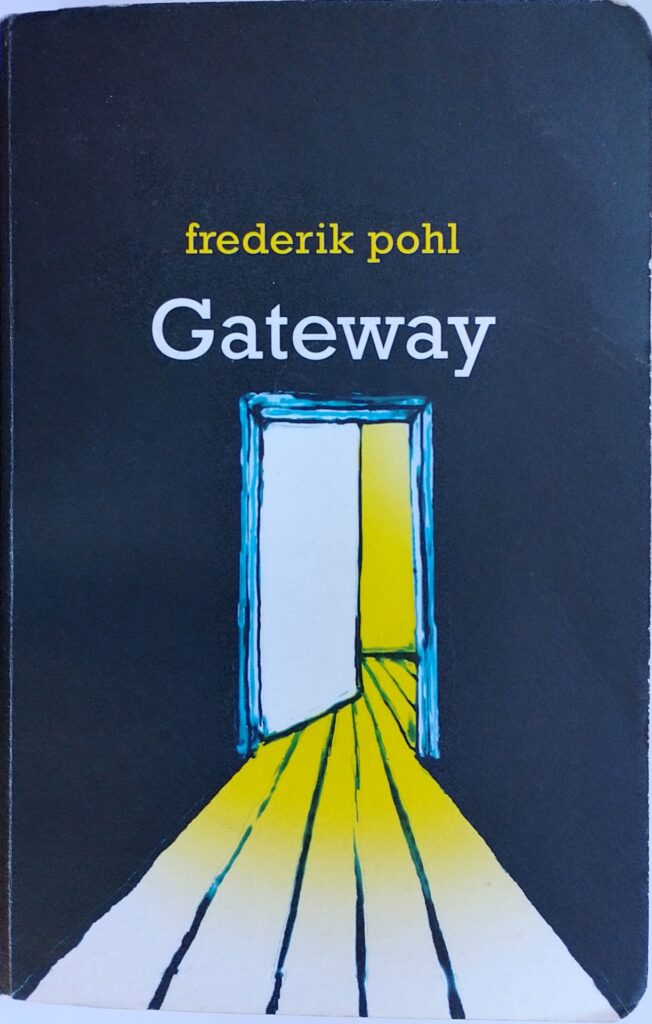First published 1976. Gollancz paperback, 2006, pp 293 (inc. c.60pp illustrations/notes), c.70,000 words (main text).
Pohl was a big figure in the SF community in America in the 20th century, acting as a literary agent, SF magazine editor, as well as conference and society presidents. He published many stories in magazines, under his own and other names, often co-written most notably with C. M. Kornbluth, with who he also wrote a number of novels. This book won the Hugo, Nebula and John W. Campbell awards in 1977/78.
We first meet Robinette Broadhead undergoing analysis by ‘Sigfrid’, an electronic machine. We are told that Broadhead is among the wealthy elite, living under the dome in New York. This might be Woody Allen territory, and indeed, there is much comedy to be had in the interactions of the two that occur throughout the book. What we are here to learn is how Broadhead came to be rich and in need of psychiatric help – or so he thinks. The starting premiss is a familiar one in SF of the time – a world grossly over populated, with twenty-five billion people crammed together and on the verge of starvation [p107]. Broadhead started out by following in the family tradition of working in the ‘food mines’, actually extracting hydrocarbons which are converted by the use of algae into food. He gets lucky and wins a large lottery prize which is enough to buy him a ticket to ‘Gateway’, an asteroid that was once occupied by a mysterious alien race, the Heechee, and is now controlled by a global confederation. Gateway is a cosmopolitan place, drawing people from all over Earth and beyond. Women are well represented. The asteroid contains many Heechee spacecraft but no instructions on how to use them. Taking a ride in one maybe a suicide mission, or it may bring great riches in the form of alien artifacts or scientific knowledge. Broadhead, like all the others who have made it to Gateway, has to decide whether or not to throw the dice. The clock ticks remorselessly down.
Pohl creates a realistic future scenario, even if we are no longer obsessed by global over-population. The discovery of alien artifacts is a staple of science fiction, and Pohl’s invention is remarkable for the lack of human’s ability to understand the race that created them, the objects’ purpose or how they are operated. All we can tell is that the aliens’ anatomy was different from ours judging by what appear to function as seats in the spacecraft. This lack of ability to interpret the Heechee makes them truly alien – their absence is visceral.
Through the analysis sessions we come to realise that Broadhead is a deeply disturbed character. Some terrible things have happened to him or have been perpetrated by him. It is a dog-eat-dog world. Luck can turn either way in a moment. This aspect of all life is subtly drawn out by the analyst, even though Broadhead thinks he has got the better of him/it. While we find their sparring amusing, it opens a passage into Broadhead’s past and ultimately his soul. By the end it is clear that this is not a jolly space-romp after all. Broadhead has his warts and some of them are of the deepest black.
While the main text is a relatively straightforward construction of analyst sessions interleaved with flashbacks, there are accompanying pages scattered throughout the book that do not form part of the narrative but contribute to it, as might illustrations. Sometimes these contain simple bits of gobbledegook computer code, presumably from the analyst, sometimes they are ‘classified adverts’ from the Gateway news service (often amusing), and sometimes they are reports from ‘missions’ written in the dry tones of secret official reports which sanitise the ghastly lottery of taking a ride in one of the alien spacecraft. These are a bit distracting (where does one stop reading the main page and read the illustration?), but they do help create atmosphere so should be read roughly where they are placed next to the text. It is a bit free-and-easy, experimental, 1970s, but not disastrously so. There are several other echoes of the ‘70s that seem to have reoccurred in this future: people smoke a lot, but a few are starting to push back, ‘tapes with earphones’ are in use, as is the SST, even if it didn’t quite make it the first time around.
Pohl invented the starbow in fiction (The Gold at Starbow’s End, 1972) and he reprises that lovely notion here [p131]: as they approach the speed of light the stars change colour and apparent position, eventually disappearing as the traveller crosses that forbidden boundary. Pohl’s science is usually spot on.
The writing is clear and easy to read: there are no literary pretentions. The characters are well drawn and fully credible, except perhaps a child ‘maybe a year and a half’ who asks rather articulate questions: ‘Are you a friend of Klara’s?’ [p80] and ‘Are you having an argument’ [p83]. There are a couple of scenes that are horrifying, particularly one of sudden domestic violence. I don’t need such graphic accounts, but they are real enough.
This is a very imaginative book, presenting a very well-conceived future. The story slowly peels back the layers to expose real human thought and behaviour, sometimes humorously and sometimes horrifically. It is to a degree an experimental work and of its day but still well worth reading. Pohl was a true master of the genre.

